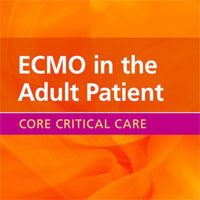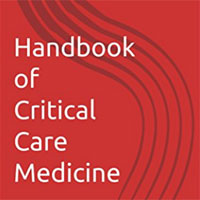Tag: tools
ECMO in the Adult Patient (Core Critical Care)
Extracorporeal membrane oxygenation (ECMO) is developing rapidly, and is now part of the toolkit for the management of all patients with severe respiratory or cardiac failure. Clinicians of all disciplines are in need of... read more

Cardiorespiratory Compromise in the Perioperative Environment
Perioperative cardiorespiratory compromise is common and goes largely undetected. Predictive cardiorespiratory indices can help in early detection of harmful deviations and guide preemptive treatment. Using continuous... read more
The Bougie as an Airway Savior
Ever since the BEAM (Bougie Use in Emergency Airway Management) trial was published in JAMA in 2018, the use of the bougie has become increasingly mainstream. Some of the advantages of using a bougie are known, but there... read more
Perceived Barriers to Rapid Response Team Activation Among Nurses
The purpose of this literature review was to investigate the major barriers nurses face when it is necessary to seek additional assistance and resources by calling the rapid response team (RRT) in order to manage and stabilize... read more
Echocardiographic Assessment of LV Diastolic Pressure
The ever-increasing trend toward noninvasive monitoring puts echocardiography at the forefront and considerable effort has been made to define its role in this setting. Invasive pressure measurement is the only accurate... read more
Clinical Impact and Assessment Tools Capable of Identifying Delirium in Cardiac Arrest Survivors
This review aims to describe the clinical impact and assessment tools capable of identifying delirium in cardiac arrest survivors and providing strategies aimed at preventing and treating delirium. Patient factors leading... read more
Patient Safety Organization Drives Inpatient Rehabilitation Quality Improvement
The Carolinas Rehabilitation Patient Safety Organization (PSO), which serves 34 freestanding inpatient rehabilitation hospitals and inpatient rehabilitation units, is facilitating the improvement of quality and patient safety... read more
Feasibility, Safety, and Utility of Advanced Critical Care Transesophageal Echocardiography Performed by Pulmonary/Critical Care Fellows in a Medical ICU
Critical care transesophageal echocardiography is feasible, safe, and has clinical utility. It can be safely and effectively performed by fellows within the context of their critical care training with faculty supervision.... read more
Sophia Observation Withdrawal Symptoms-Pediatric Delirium Scale
The SOS-PD scale shows promising validity for early screening of Pediatric Delirium (PD). Further evidence should be obtained from an international multicentre study. A total of 2088 assessments were performed in 146 children... read more
The Right Tool for the Right Patient
Resuscitative TEE in the diagnosis of massive PE in the ED. We have multiple tools in the ed that allow us to assess patients rapidly. But of course, you must use the right tool for the patient. transthoracic echo (TTE) can... read more
How Big Tech Is Going After Your Health Care
When Daniel Poston, a second-year medical student in Manhattan, opened the App Store on his iPhone a couple of weeks ago, he was astonished to see an app for a new heart study prominently featured. People often learn about... read more
Predicting outcomes after trauma to the brain
UMMS researchers help develop novel tool to predict survival after penetrating brain injury. Using the new tool they developed, the SPIN-Score (Surviving Penetrating Injury to the Brain), two factors were by far the strongest... read more
Study suggests a new tool for diagnosing post-concussion syndrome
Unlike more common diagnostic tools, including magnetic resonance imaging and computerized axial tomography scan, diffusion tensor imaging, or DTI, effectively scans for micro abnormalities that may often go undetected by... read more
Building Critical Care Community Through Twitter Chat
Twitter chats can be a powerful tool for the widespread engagement of a medical audience. Social media sites such as Twitter can significantly enhance education and advocacy efforts. In 2013, the American College of Chest... read more
Virtual Hospital Monitors Patients at Eight Facilities
In a bunker-like former bank office near Tacoma' Hilltop neighborhood, 200 nurses, physicians and other health care staff spend their days treating scores of hospital patients they never meet using webcams, two-way speakers... read more
Transthoracic echocardiography: an accurate and precise method for estimating cardiac output in the critically ill patient
Cardiac output (CO) monitoring is a valuable tool for the diagnosis and management of critically ill patients. In the critical care setting, few studies have evaluated the level of agreement between CO estimated by transthoracic... read more
Wireless ICM Captures Vital Information
The world's first smartphone-enabled, insertable cardiac monitor (ICM) provides powerful data to help monitor irregular heartbeats, unexplained syncope, palpitations and suspected atrial fibrillation (AF).... read more
Integration of Single-Center Data-Driven Vital Sign Parameters into a Modified Pediatric Early Warning System
Pediatric early warning systems using expert-derived vital sign parameters demonstrate limited sensitivity and specificity in identifying deterioration. We hypothesized that modified tools using data-driven vital sign parameters... read more
Toolkit To Improve Safety in Ambulatory Surgery Centers
The Toolkit To Improve Safety in Ambulatory Surgery Centers helps ambulatory surgery centers (ASCs) make care safer for their patients. ASCs can use the toolkit to apply the proven principles and methods of AHRQ's Comprehensive... read more
MRI in Pulmonary Embolism Diagnosis
Magnetic resonance imaging (MRI) has high specificity but limited sensitivity for the diagnosis of pulmonary embolism (PE), according to a systematic review published in the journal Thrombosis Research. Given these inconclusive... read more
Digital tools should not adversely affect the doctor-patient relationship
For years at Partners HealthCare, we’ve been remotely monitoring patients with congestive heart failure, using a combination of vital signs, patient-reported symptoms (the digital component) and a nurse call center run... read more
Many Spirometers Used in Primary Care Deemed Inaccurate
Spirometers used in primary care offices are frequently inaccurate, according to a study published online Sept. 6 in the Annals of the American Thoracic Society. Applying percent error to clinical data set resulted in re-categorization... read more









